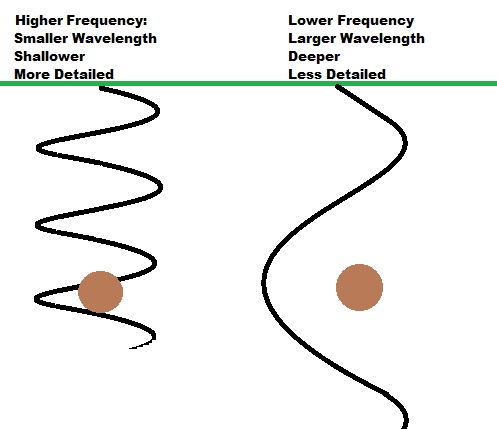GPR Antennas Come in Different Frequencies
All GPR antennas are considered safe around humans. In fact, a cell phone has 50 to 1000 times more output than GPR. With that said, when someone asks whether GPR is safe, a common response is that, “If it’s safe to use a cellphone here, it is safe to use GPR.”
GPR antennas are available in 12.5, 25, 50, 100, 250, 500, and 1000MHz. Generally, 50, 100, 200, 250, 500, and 1000MHz Noggin antennas are the most popular systems for GPR because of their combination of resolution and depth.
The lower frequency antennas have larger wavelengths. This has a few ramifications. First, larger wavelength pulses can not be transmitted with small antennas very well. Therefore the lower frequency antennas are physically larger. 12.5MHz antennas are 8 meters long! However, a 250MHz antenna is about 0.5 a meter.
A lower frequency (larger wavelength) antenna will penetrate deeper into the ground. However, because the wavelength is longer, the response is less detailed.
Notice that the lower frequency signal missed the object. However the energy from the lower frequency pulse was likely absorbed less by soils, so, it was likely able to penetrate deeper.
One method of choosing an antenna size is based on what is the smallest object the user would like to see at a particular depth. In the best conditions, the depth to size ratio is 24 to 1. So in perfect conditions, a user could spot a 1 inch object 24 inches deep. Click here to read more about GPR limitations.
In good conditions, radar can penetrate extremely well. However, not all conditions are perfect. In general, the less conductive the soil, the better radar will penetrate. Therefore, GPR does well in sandy soils and worse in wet clay soils. Below is a table, based on the manufacture, of the maximum depth that each antenna frequency can penetrate in very good soil conditions. Unfortunately, job conditions often make these depths impossible.
It is important to note that depth is an estimate and dependent on velocity. GPR determines depth by measuring the time it take for the radar signal to travel to and from an object at a predetermined average velocity. D = V x T/2. Read lessons on velocity analysis for more details.
Remember…
Lower Frequency:
Larger GPR Antenna
Often Penetrates Deeper
Less Detail
Higher Frequency:
Smaller GPR Antenna
Often Less Penetration
More Detail

